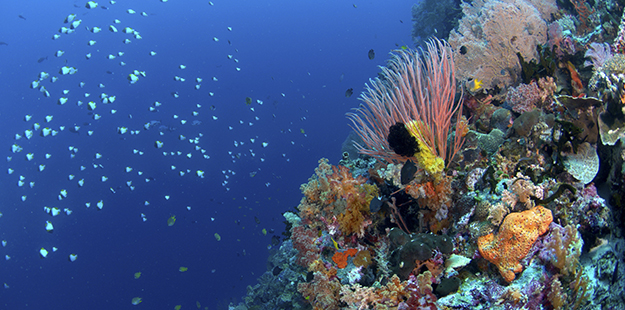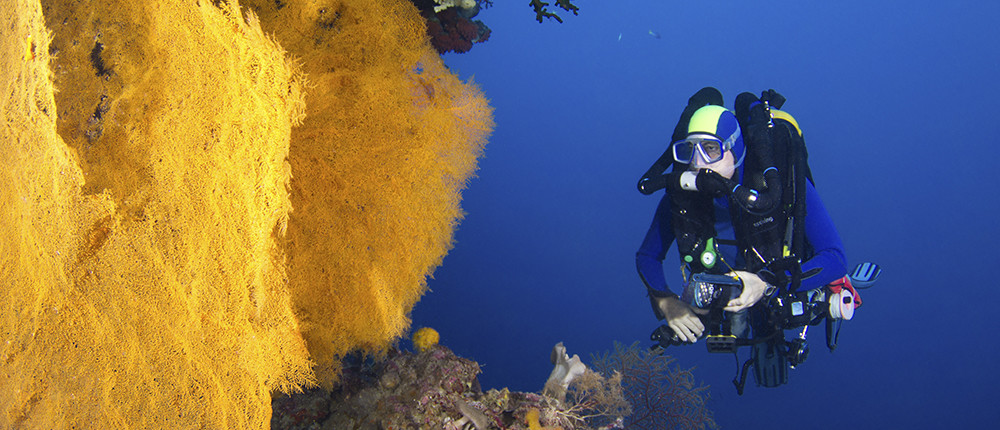A CCR Experience Without Equal
Considerations and conditions
Any CCR divers planning to visit Wakatobi should be certified on the equipment they bring. The resort is not currently geared to providing “rebreather experience” dives or basic training on CCR equipment, and visiting groups are not allowed to perform their own classes, as the instructing would require an Indonesian permit. The dive center stocks spare parts for AP Diving CCRs, but divers diving other brands will need to carry any spares they feel necessary. A better option for those seeking to begin or enhance their CCR skills would be to complete an entry-level course (no deco, air diluent, 30m max depth) pre-trip and then collect hours on the unit during a Wakatobi holiday. While at the resort, divers trained on AP Divers CCRs could also engage Lorenz as a private instructor, and complete a second-level course (deco, air diluents, 45m max depth).
“Our last group was all about the quality of bottom time, not just the quantity,” Willemsen says. “We typically stayed down longer on each dive, but we made fewer dives each day.” Instead of the five-dive-a-day schedule that some guests employ, the rebreather group usually made three dives a day, each lasting anywhere from 90 minutes to more than two hours. Profiles typically began with a visit to the deeper portions of the reef at 130 to 150 feet, with ascents that skirted decompression while taking advantage of the fixed PO2 gas mixtures rebreathers provide, he says. Because Wakatobi’s reefs come within mere feet of the surface, what might be considered a safety or deco stop at other places becomes an extended hangout on the light-filled shallows atop Wakatobi’s protected reefs.
“One of the best things about diving a rebreather is the silence. We had a smaller group that was really squared away underwater, and we were able to spend more time with any given subject without worrying about gas duration or decompression obligations.”
Many of the group’s extended time dives were conducted as long drifts over two sites, connecting what would otherwise be two separate dives. Among these connections were Fan 38 East and West, from Galaxy to Fan Garden, Cornucopia and Magnifica together, and the entire length of Roma.
“In the end, we probably racked up a bit more bottom time than the open-circuit guests, but that wasn’t the big payoff,” Willemsen says. “One of the best things about diving a rebreather is the silence. We had a smaller group that was really squared away underwater, and we were able to spend more time with any given subject without worrying about gas duration or decompression obligations.” This combination of silence and time allowed the group to not just see the fish, but to enjoy the luxury of extra time and the silence needed to truly become familiar with the intricacies of life on the reef.

Because many of Wakatobi’s reefs come within mere feet of the surface, what might be considered a safety or deco stop at other places becomes an extended hangout on the light-filled shallows. Photo by Walt Stearns
CCR on the House (Reef)
CCR can also provide some remarkably long bottom times when diving in the shallower waters of the resort’s renowned House Reef. Divers can easily access the House Reef day or night (monitored from 6am to 10pm) by wading in from the beach right in front of the resort, or by using the ladder off the jetty. Taxi boats are also available during daylight hours to drop divers up current, allowing for a nice long drift along the edge of the wall, ending back to the resort.
On the House Reef, CCR divers are asked to follow the same basic protocols as open-circuit scuba divers – either go with a buddy (also on CCR) or have a CCR instructor or solo diver qualification. Currents on the House Reef can range from mild to fairly wild during rising and falling tides. Wakatobi’s dive center recommends for dives longer than two hours that CCR divers tow a small surface marker to show their position. This allows the staff to monitor the divers’ location (since there are no bubbles) and ensure that they are not drifting too far away.

CCR divers can be dropped up current of the resort, allowing for a nice long drift along the edge of the wall, ending back to the resort. Photo by Richard Smith
According to Lorenz, the shallower depths of the House Reef, combined with the constant PO2 advantages of CCR, make it possible to do very long dives safely. In theory, you could spend up to 10 hours exploring the reef shallows, depending on the personal metabolism and equipment configuration. Lorenz has personally made dives of six hours, ending it there because, “well, then I got hungry.”
The warmth and clarity of the water further enhances the enjoyment of extended-duration dives at Wakatobi, Willemsen says. “Overall, it would be hard to imagine a more perfect environment. You don’t have to dive a rebreather to experience all the wonderful attractions of Wakatobi, but having these systems can add yet another layer to your enjoyment of this magnificent ecosystem.”
For more information about Wakatobi’s rebreather support services, or to plan a trip, contact our office at office@wakatobi.com, or complete a quick trip inquiry at wakatobi.com. A guest experience consultant will be in touch with you to answer any questions and provide information about taking your rebreather to Wakatobi.
Visit us on Facebook and Instagram. Find great Wakatobi videos on YouTube.


